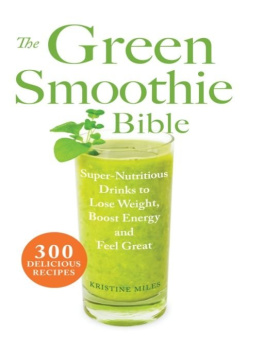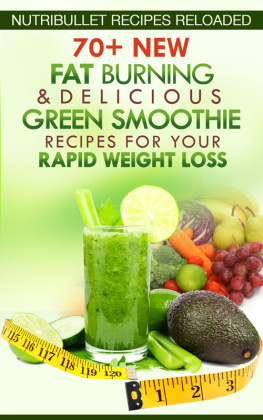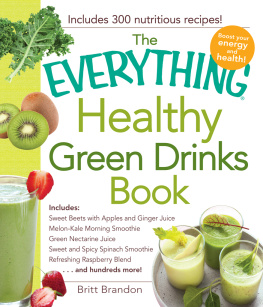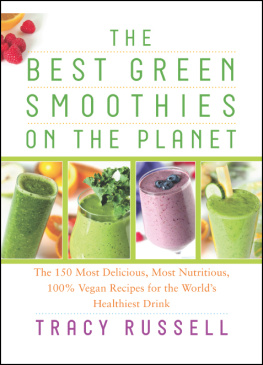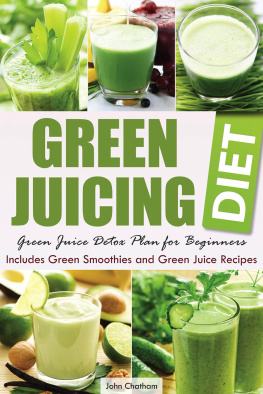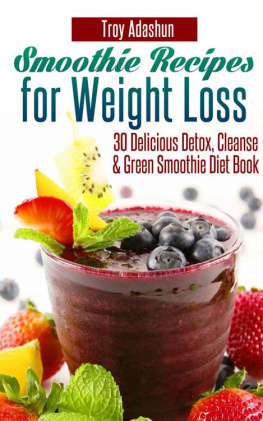Table of Contents
Introduction
While visiting a girlfriend in the United Kingdom last year, I made a green smoothie for her 18-month-old daughter. Little Alice was fascinated by the whirring of the blender and the evolving bright green liquid. I placed a small cup in her willing hands, and as she tasted the smooth green liquid for the very first time, she relished itand so did much of her face.
I wasnt lucky enough to discover green smoothies at 18 months of age, but I believe I reached a high point in my digestively challenged journey at 33 years. In seeking improved health and well-being, I read many books, researched online, visited health professionals, experimented with different ways of eating, and experienced many aha! moments along the way. I removed wheat and dairy from my diet, and ultimately all gluten-containing foods, got rid of coffee, reduced the amount of sugar, returned to a vegetarian diet, discovered raw foods, and finally came upon green smoothies!
I lead a busy life as a full-time physiotherapist along with running two other home-based businesses, writing, and being a wife to my best friend, Ben. People ask me where I get my energy and I believe its partly attitude, as I am a persistent, committed, and optimistic person. I also eat a clean, unprocessed diet. I dont consume foods that disagree with me, I eat a high proportion of raw plant-based foods, and I drink a green smoothie every morning without fail. Whether I am up early or late, traveling or at home, a green smoothie is a must for me as it is for my husband. Just 16 ounces or 2 cups (500 mL) sees me through to lunchtime with ease, with no blood sugar dips. Its easy to digest in the morning and so very convenient. In 3 to 4 minutes I have a smoothie prepped and made, and the blender cleaned, and if I am in a hurry, the smoothie is easy to transport to work in a glass jar.
In 2007 I built a website devoted to green smoothies. What started as an opportunity to share what I had learned, and to post some of my favorite recipes and photos, became a much bigger deal, with thousands of hits and wonderfully supportive feedback from people ranging from novices to experienced green smoothie drinkers. Now I am thrilled and so very grateful to turn my passion and hobby into The Green Smoothie Bible , which contains everything you need to know about green smoothies, including what they are, how they benefit your body, and, of course, all the recipes you need to get going.
Warm and green regards,
Kristine Miles
PART ONE
About Green Smoothies
What Are Green Smoothies?
A green smoothie is a fruit smoothie with raw leafy greens blended through it so that it tastes like fruit but looks green. Although greens are incredibly nutritious, many people struggle to eat enough of them. Adding fruit makes the greens taste great and is also a clever way of getting more fruit into a diet. Some people lack both fruit and greens in their diets, and green smoothies are a delicious way to fulfill both needs.
People who have introduced green smoothies into their diets report many health benefits such as clearer skin, improved digestion, weight loss, and better mood. Those following a raw food diet have especially embraced this nutritional powerhouse to boost an already nutritious diet, often finding some missing element that helps them achieve excellent health and vitality.
What Goes into a Green Smoothie?
I have to start by saying that green smoothies dont taste horrible! Although they are green, they taste like the fruit in them. Obviously, if you go overboard with greens, the smoothie will taste like the greens in it, but generally you dont taste the greens much, if at all. The green smoothies in this book are raw and mostly vegan, meaning no cooked or pasteurized ingredients and no dairy products, which are the base of traditional smoothies. This means no recipe uses cow, goat, or sheep milk or yogurt, nor any pasteurized milks such as soy, rice, or oat. As alternatives to water, only non-heat-treated, plant-based milks made from raw nuts and seeds are used in these recipes. When I say mostly vegan it is because some of my recipes do contain bee products such as pollen and honey. These are optional, of course.
Generally, I recommend using 40 percent greens and 60 percent fruit. For beginners, start with about 10 percent and gradually increase over time. If you do happen to overdo the greens, try some sweetener, a bit of vanilla, or some lemon juice to take the edge off.
How to Make a Green Smoothie
Making a green smoothie couldnt be easier. All you do is put greens, roughly chopped fruit, and liquid (usually water) in a blender and blend for 1 to 2 minutes. It doesnt matter in what order you add the ingredients (I put the liquid and solids in at the same time). If the recipe calls for water, ideally use filtered or pure spring water. Some recipes call for juice, nut milk, or herbal tea as the liquid base. Always blend the ingredients thoroughly to break up and incorporate the greens. Serves 2.
BEGINNERS RECIPE
3 to 4 ripe bananas
1 teaspoon vanilla extract
2 cups water
handful of fresh, clean spinach
All recipes in this book make around 1 quart (1 liter), enough to fill two large glasses each holding 2 cups (500 mL) of green smoothie.
I am a fan of using as few ingredients as possible so I can actually taste whats in the smoothie. Combine six different fruits if you like, but the result is usually a smoothie with an ill-defined and uninspiring flavor. For instance, you will taste both banana and berries in a banana-berry smoothie, but add apple, pear, and peach and the smoothie gets very confused.
My best advice is to use ingredients that you enjoy eating; otherwise you will be less inclined to drink them. Just because you are drinking something extremely healthy does not mean it cant taste great. When inventing your own concoctions, youre bound to have the odd failure no matter how much you try to adjust the flavor. Dont worry! Just drink it and learn from that mistake.
The greens I most commonly use are bok choy, kale, mint, parsley, spinach, and Swiss chard. Spinach is a great choice for beginners as the flavor is mild and the green color often spectacular. Less often I use basil, beet greens, borage leaves and flowers, carrot tops, celery leaves, cilantro, fennel tops, purslane, radish tops, and romaine, but they are still excellent additions that can liven up a typical green smoothie. I have also experimented with regular salad mix when my greens for green smoothies container in the fridge runs low. Keep in mind that red leaves in salad mixes are generally bitter, and you may want to pick those out.
Dont use the same greens all the time; try different ones, and also rotate greens to respect the seasons. It is important to get a variety of nutrients and to avoid continually consuming the same plant-produced chemicals known as secondary metabolites (and sometimes called anti-nutrients). For example, Swiss chard and spinach contain oxalic acid, and if you use only these two greens, you may start to have problems. One issue with oxalic acid is that it binds with calcium, which decreases absorption of this important mineral. I can tell if I have been eating too much of the same greens because I start to not want smoothies and I feel a bit queasy midmorning. (See page 80 for more on the importance of variety.)
Making green smoothies is a snap if you wash the greens and have them ready to use ahead of time. Use just the leaves of greens with fibrous stalks like kale and chard (the stalks can be used finely sliced into salads or whole in soups and stir-fries). After washing the greens, air-dry them on dish towels and then put them in a large plastic container lined with a clean, dry towel before storing in the refrigerator. The towel absorbs excess moisture and stays hygienic for 5 to 7 days.

